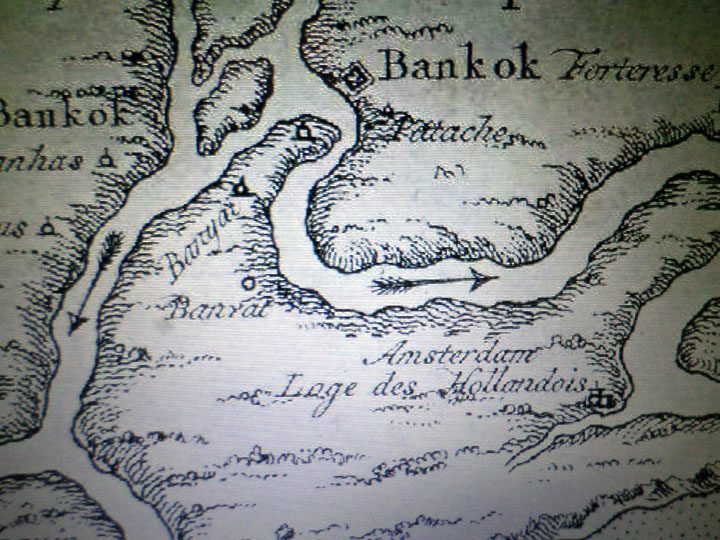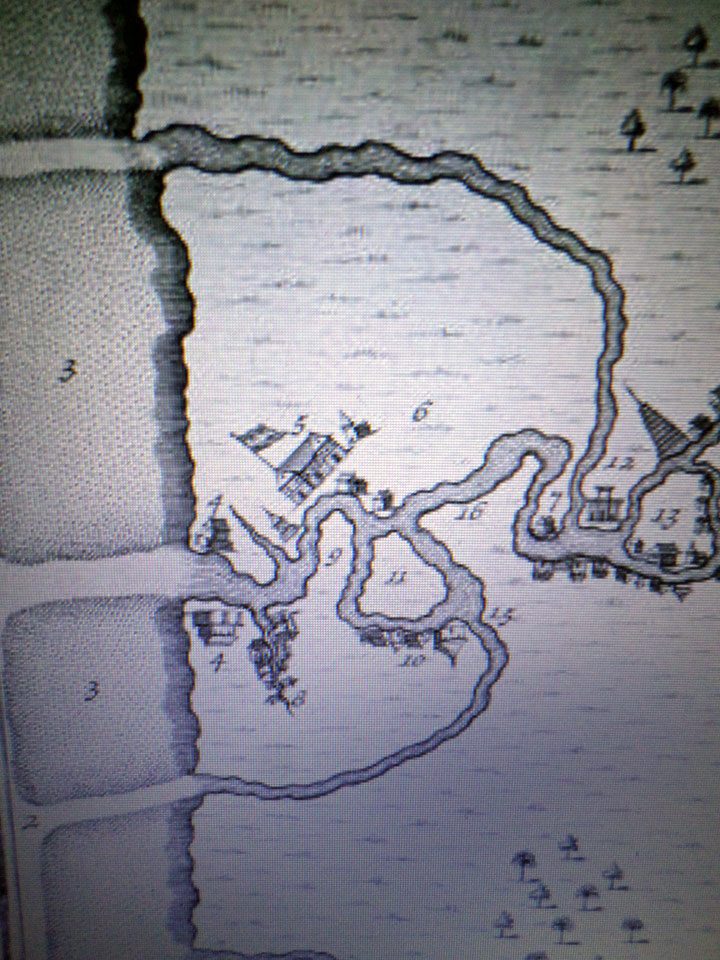The disappeared VOC warehouse 'Amsterdam'

Pakhuis Amsterdam on a map from around 1753
The Factorij or the trading post of the Vereenigde Oostindische Compagnie (VOC) in Ayutthaya has already caused a lot of ink to flow. Much less was published about the VOC warehouse in Amsterdam, south of Bangkok.
However, the importance of this trading post should not be underestimated because for decades it held a key position within the VOC infrastructure in Southeast Asia. The construction of this smaller trading post not only demonstrated the privileged position of the VOC in Siam, but also testified to the cunning and mercantilism of the VOC leaders.
Ships trading with Ayutthaya had to pass the settlement of Bangkok on the Chao Phraya, on their way to and from the sea, where a fortification had been built at a large sandbank that served as a toll house. Here they had to indicate where they came from and how many people, artillery and merchandise they had on board. At a second toll house, a little further on, toll, either import or export tax, had to be paid on these goods.
However, the Dutch, who had forced the Siamese into privileges, still had to pay tolls like everyone else, despite their privileged position, and of course they didn't like that too much. Because these taxes depressed the profits of the VOC and therefore some creativity had to be shown. Under the pretext that the water level of the Chao Phraya sometimes dropped so low in the dry season that the Dutch ships could not reach Ayutthaya due to their deep draft, or got stuck there, the VOC built around 1630 a few kilometers downstream from Bangkok at Pak Nam, the mouth of the Chao Phraya in present-day Samut Prakan on the western bank of the place where the Bang Pla Kod channel flows into the river, a warehouse, which was endowed with the name of Amsterdam. Because of the simple fact that this trading post was opposite the first and in front of the second toll house, the VOC cunningly managed to evade a considerable amount of import and export duties and trade could still be conducted even at low water levels. So two birds with one stone.
Within a short period of time, this economic-strategic masterstroke proved to be lucrative. Originally built as a large wooden storage shed on stilts, this building was already expanded in 1634-1636 with a brick factory building. Coincidence or not, but in that same year the VOC had lent a hand to the Siamese monarch Prasat Thong in his attack on the rebellious southern sultanate of Pattani and perhaps he showed his gratitude by turning a blind eye…. Incidentally, 1634 was also the year that the Logie, the imposing brick main building in the VOC factory in Ayutthaya, was completed and it is quite possible that the masons and carpenters who had been involved in this project also built the Amsterdam warehouse.

Pakhuis A'dam (nr.5) on Dutch map
Goods were stored in the Amsterdam warehouse that Siam supplied to the VOC for export, such as tin, rice, oil, wood, deerskins, ivory tusks of elephants and ray skins. The latter were used as a kind of sandpaper to polish tropical hardwood. But the Amsterdam warehouse also stocked imported goods such as fabrics, wool and linen. Shortly after the brick building was completed, a number of residences for VOC employees were also built nearby and the entire site was reinforced and fortified in order to secure the merchandise. There was a large hut that served as quarters for a detachment of soldiers, which averaged about twenty men, and according to the scant documents that have survived about this site, there were also a blacksmith shop and a carpenter's workshop on the site of the warehouse. This trading post, unlike the main house in Ayutthaya, did not offer an attractive living environment. Various contemporary testimonials show that this VOC outpost was located in a swampy area that was infested by, among other things, thick swarms of mosquitoes, while the massive presence of saltwater crocodiles, eager for a tasty Dutch snack, were always lurking...
After the fall and subsequent destruction of Ayutthaya in 1767 brought an abrupt end to the VOC's trading activities in Siam, the Amsterdam warehouse fell into disrepair and was swallowed up by the encroaching mangrove forest. Until late in the nineteenth century, some travelogues still mentioned the ruins on this site, which, according to these authors, were often described by the Siamese as the 'Dutch Foolishness'.
In April 1987, a number of Shell engineers commissioned by the Siam Society and led by HJ Krijnen inventoried, measured and mapped the remains of the Amsterdam warehouse. A few wall fragments and foundations were all that remained. It was probably as a result of this inventory that a plaque with the following text was placed on this move:
'New Amsterdam City was one of the significant historical sites which was situated at Tambon Klong Bang Pla Kod, Phra Samut Chedi district. In Samut Prakan Province in those days a large number of Dutch men came to trade with Thailand. These Dutch men were well-behaved and cordial in conducting their business with Thai people. Some of them provided good service to the government. They were thus bestowed with some land on the western bank of Bang Pla Kod Canal to be used for storage and residences. The place looked so nice that it was known among the Dutch men living there as New Amsterdam or the Holland Buildings. Later, the mutual relationship began to deteriorate until the end of the Ayutthaya Period an so did the significance of New Amsterdam. Time also strengthened the decline of the riverbank where the Holland Buildings were situated. They were eroded by the tide. That is why no traces of such places can be seen today.'


Thanks for this great documentation. This was also unknown to me and is a very educational piece.
Thank you Lung Jan
The surgeon employed by the VOC, Gijsbert Heeck, visited Ayutthaya at the end of 1655 and also describes the Amsterdam warehouse and the rural surroundings.
… The City of Amsterdam is paneled with a large, solid and strong wooden packhouse of thick heavy beams and planks, joined together, covered with tiles, the approximately one and a half man's length of the earth, raised on many poles, on which the wicker and other dry goods, doaer the better in weather (against the dampness hitting from below), because kijaten (teak) and other lumber is usually abundant enough to be obtained here, which is why old ships have often been sent here to repair and to make whole. refurbishment, because it can be done here with less costs (as even on Batavia)…'
Floods were already common then and were beneficial and necessary:
'... The soil is completely submerged over all low-lying swamps, flowing (once a year) for several months (due to the strong water pushing from above), so that one can sail over the land, without which current, it is quite possible. would remain barren and barren, like the Nile loop in Egypt...'
Thanks for the addition Tino…!
Another beautiful piece John! But if I may be so bold as to submit a request: I myself would like to read a bit more about the common people.
I can recommend the book if you want to take a look at that period of the VOC.
A Traveler in Siam in the year 1655, passages from Gijsbert Heeck's diary.
The team that made this book includes Han ten Brummelhuis, author of 'Merchant, Courtier and Diplomat', a book about the contacts between the Netherlands and Thailand, which was presented to His Majesty on the occasion of his 60th birthday in 1987. (ISBN 90352-1202-9 De Tijdstroom, Lochem, a book with a lot of information).
Experts such as Dhiravat na Pombejra (lecturer at Chulalongkorn University), Remco Raben (associate professor at Utrecht), Barend Jan Terwiel (historian and Thailand expert) and Henk Zoomers (publicist on this part of the world) also contributed.
The book was made possible in part by a contribution from the Prince Bernhard Culture Fund.
Publisher
ISBN 978-974-9511-35-02, Silkworm Books, Chiang Mai.
Good of you to name this book, Erik. The quotes above are from that book. One of the best descriptions of Ayutthaya and the journey there.
Dear Lung Jan,
Nice and good piece, the 'Trippenhuis' also had a large part to do with this.
Like trading arms.
Yours faithfully,
Erwin
The remains at the mouth of the Bang Pla Kot channel mapped by some Shell engineers in 1987 were those of the Thai Khongkraphan Fort dating from the 19th century and not the Pakhuis Amsterdam. I have done research on this and also wrote an article about this for the Siam Society in 2014. Those interested can download the article here:
https://thesiamsociety.org/wp-content/uploads/2014/04/JSS_102_0g_Dumon_AmsterdamTheVOCWarehouse.pdf
Dear,
Mea culpa… So I was misled by the article that Elisabeth Bleyerveld-van 't Hooft published in the Siam Society newsletter in 1987… Fortunately, there are still enterprising and curious Farang who undertake expeditions to connect the dots and cross the t's. to make. Thanks for that… And luckily the Siam Society is correct enough to correct itself. An attitude that is unfortunately not always 'common practice' in Thai historiography...
Unnecessary Mea Culpa, Jan. I also learn from your texts and these sometimes encourage me to do further research. I would like to know the reference of the text (or texts) linking Singhanagari to Songkhla in the Nagarakretagama (in your previous piece). My cycling trip in southern Thailand in March was interrupted by the Covid turmoil and so unfortunately I was unable to visit Singora. I am still gathering information on this subject, as I hope to carry out this tour next year. I welcome any additional information pre-17th century in your possession.
https://www.routeyou.com/en-th/route/view/6889398/cycle-route/singora-bicycle-track
Dear,
I wrote this article over a year ago. I can't remember one, two, three which sources I used in the past and, thanks to corona, I've been at a small 10.000 km from my work library for months now, where not only my books but also my notes are…
Wonderful to read and still relevant today that a small country like the Netherlands always pushes the boundaries to get the most out of it.
For some, paying taxes is a shame, but if VAT and import duties still have to be paid, then the system of transferring VAT is much better than the outdated Thai system, but yes it keeps people working and see here the hand that is often not understood . Hidden unemployment is largely covered by companies dealing with government bodies.
My interest in this VOC period has expanded to my coins and notes collection, but unfortunately I have only been able to find 1 coin so far, namely 1 beautiful copper duit from 1790.
Should readers-collectors and/or casual readers own something like this and perhaps no longer know what to do with it, I can always show interest in buying it up or exchanging it, as I also have duplicates from many countries.
I myself am currently in Belgium (W-Vlaanderen), so the contact here can be very easy.
My Thai wife is currently still with family around Bkk, and will join me here next month.
So she is available on site for contact.
Around half of 2022 we will leave together again for Thailand.
For personal messages you can reach me at “[email protected]", and for those in Europe I can be reached via mobile +32472663762 or via whattsapp on the same number.
Thanks in advance to all those who can help me forward, even if only with solid tips.
Greetings and maybe see you soon in Thailand, Jean-Luc.